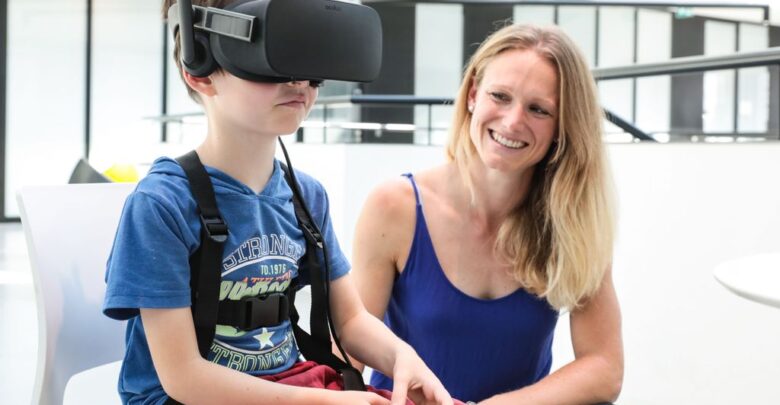

Children’s nervous systems mature over two years later than previously believed, according to a new study that found children are at risk of being overwhelmed within virtual reality (VR) environments.
Researchers are challenging assumptions about the development of children’s upper-body coordination while studying the effect of VR headsets on children. Little is known about the effects of immersive VR technology on adults, but even less is known about its effects on young children.
“Adults had no problem using simple torso movements to fly through the virtual obstacles, but I noticed that children just couldn’t do it,” said lead researcher Jenifer Miehlbradt at an event held in 2016 at Switzerland’s École polytechnique fédérale de Lausanne.
The multi-year study, which appeared in Scientific Reports, assessed children ages 6–10 and was aimed at understanding how the nervous system develops.
The coordination of torso and head movement continues to develop throughout a child’s formative years. For the last 25 years, experts have assumed that children can decouple movements of the head and torso by age eight. Miehlbradt said the model assumed that until ages 6–7, children control their upper body with rigid links between the trunk, head and arms. “After that age, children gradually learn to control all their joints independently but resort to the rigid strategy in challenging conditions,” Miehlbradt said, stressing that this old model should be revised.
“Instead, we found that when using a virtual system controlled by body movements, younger children try to move their head and body separately, while the adults use the rigid strategy,” she said.
Adults easily decouple the movements of their heads and torsos, such as while riding a bicycle. This requires integrating multiple inputs for balance and navigation from the eyes, the inner ear and proprioception — the body’s ability to sense movement, action and location.
For the experiment, the children played two games while wearing a VR headset and a movement sensor. Their abilities resembled adults’ when using their heads, but they found it difficult to use their torsos to control the games, unlike adults.
In one game, the children were asked to align their head or torso with a line at different points within a virtual landscape. By measuring the subjects’ errors and head–torso coordination, the researchers found that head control was easy for children. When the children tried to align their torso with a virtual line, the youngest ones consistently overestimated their movements, compensating with movements of the head.
In a second game, the children viewed a virtual world in which they were seated on an eagle, flying at target coins. As in the first game, the eagle’s trajectory could be controlled either with the head or torso. However, they were 80 percent closer to the coins when using their head rather than their torso.

“The results show that immersive VR can disrupt the children’s default coordination strategy,” as they tended to favor their vision over all other sensory inputs, according to Miehlbradt. Moreover, the study found that head–torso coordination does not fully mature even at 10 years of age.
The researchers reported that head control is easier in VR environments because the eyes are dominant. Using the torso for orientation requires decoupling vision from the actual control system while requiring complex head–torso coordination. VR overwhelms children because they rely on visual inputs rather than the sensation of body posture, the researchers said.
Miehlbradt also pointed out other important implications: “VR is used more and more for physical rehabilitation, particularly for children, because it’s fun and you can create lots of scenarios. But our results show that when you train movements within the VR, you do not train the natural, spontaneous movements of children. This is very important when designing a therapy.”
Edited by Siân Speakman and Kristen Butler
The post Immersive Virtual Reality May Hamper Coordination In Young Children appeared first on Zenger News.




